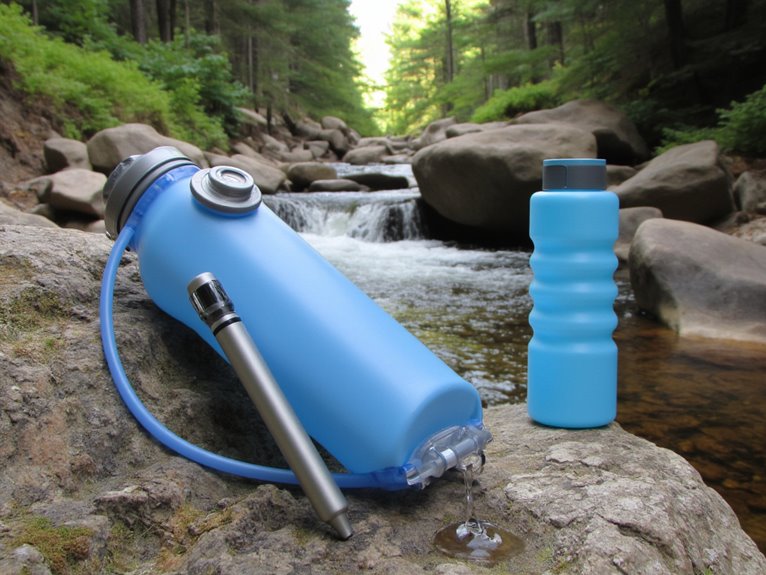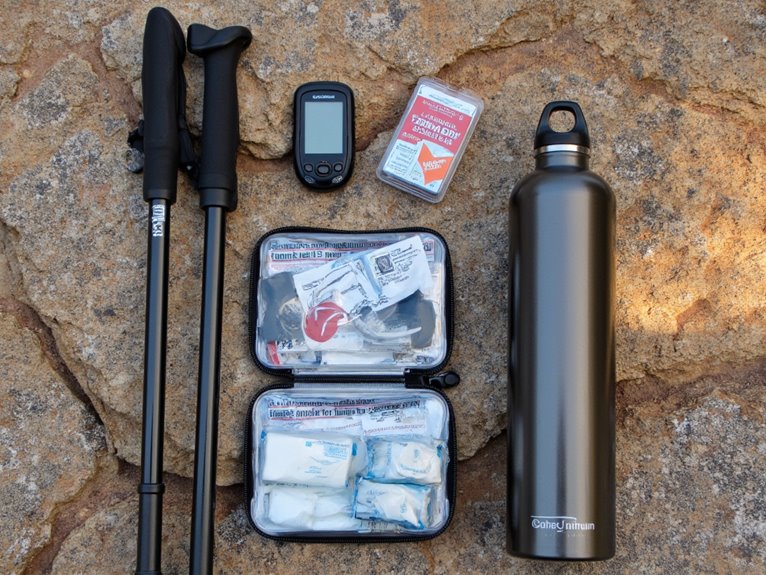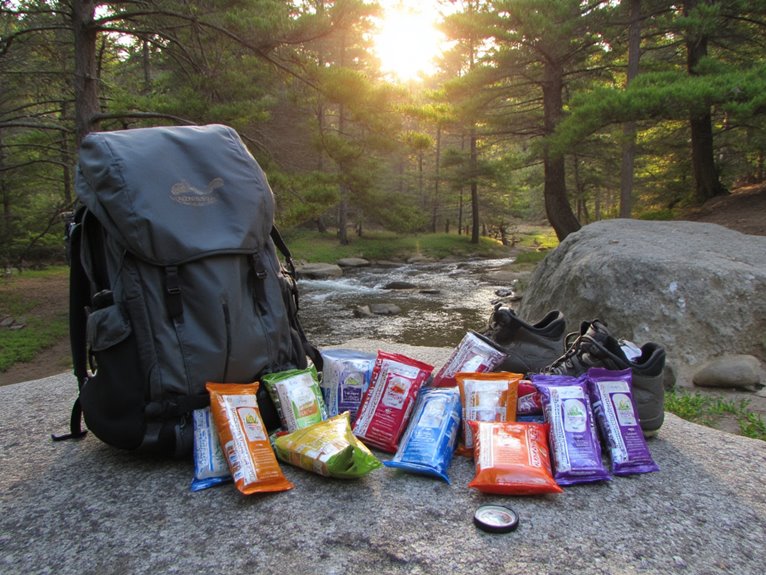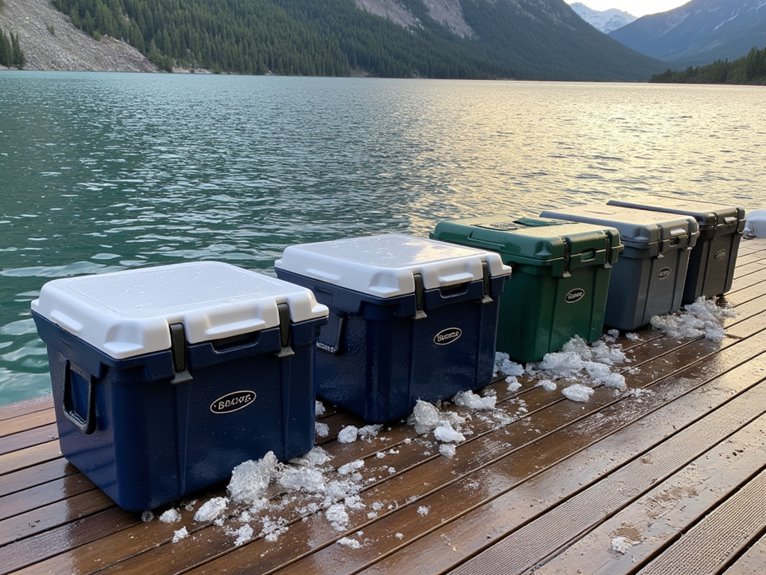The 10 Essentials for Day Hiking: Modern Interpretations
You’ll need modern gear that adapts traditional hiking safety principles to today’s technology. Essential items include GPS apps like Gaia GPS with offline maps, hydration bladders holding 2-4 liters, energy-dense snacks providing 30-60 grams of carbohydrates hourly, moisture-wicking base layers with waterproof shells, LED headlamps offering 200-400 lumens, satellite communicators for emergency signaling, multi-tools like the Leatherman Wave+, thorough first aid kits, and broad-spectrum SPF 30+ sunscreen. These updated essentials guarantee your safety while leveraging advanced materials and digital connectivity for enhanced backcountry preparedness.
We are supported by our audience. When you purchase through links on our site, we may earn an affiliate commission, at no extra cost for you. Learn more. Last update on 6th January 2026 / Images from Amazon Product Advertising API.
Notable Insights
- Modern GPS apps like Gaia GPS offer centimeter-level accuracy, but always carry traditional map and compass as backup.
- Hydration systems should hold 2-4 liters with UV purifiers or pump filters for safe water treatment capabilities.
- Layer moisture-wicking base layers, insulating midlayers, and waterproof shells while avoiding cotton materials that retain moisture.
- LED headlamps provide 200-400 lumens efficiently, paired with multiple fire-starting methods including waterproof matches and ferrocerium rods.
- Comprehensive first aid kits include prescription medications, bandages, and sterile supplies alongside multi-tools for emergency gear repairs.
Digital navigation tools have fundamentally transformed how hikers plan and execute their backcountry adventures. You’ll find modern apps like Gaia GPS and AllTrails+ offering centimeter-level accuracy through satellite networks.
These platforms provide extensive digital map integration, combining professional base maps with live user data updates. Community-driven mapping improves unmarked trail discovery by 37% compared to official maps alone.
Essential features include offline functionality-critical since 42% of hikers lose signal in valleys or dense forests. Advanced hazard alert systems now integrate wildfire and landslide warnings directly into your navigation interface. AI-powered route optimization considers elevation, water sources, and campsites automatically. FarOut provides crowdsourced information on water sources and campsites specifically for long-distance hikers.
However, you shouldn’t rely solely on smartphones. Battery dependency remains problematic. When selecting hiking footwear, many hikers recommend ordering a half size up to accommodate foot swelling during longer trail adventures. LIDAR technology can detect elevation differences as small as 4 inches, providing precise ground contour mapping when integrated with satellite imagery.
Always carry traditional map and compass as backups for extended backcountry travel.
Hydration Systems and Water Treatment

While technology handles your navigation needs, proper hydration systems form the backbone of safe day hiking.
Modern hydration technology advancements center on bladder systems holding 2-4 liters with hands-free drinking capabilities. TPU materials resist punctures while leak-proof bite valves prevent water loss. The Osprey Hydraulics 3L offers superior overall performance, while budget-conscious hikers benefit from HydraPak’s 2L Cenote model.
Modern bladder systems with TPU materials and leak-proof valves deliver hands-free hydration for serious day hikers.
Water purification methods complement your hydration setup effectively. UV purifiers neutralize pathogens quickly but require batteries. Pump filters mechanically remove bacteria and protozoa through advanced filtration. Chemical tablets provide lightweight pathogen control with required wait times. Portable filtration systems like the LifeStraw Personal offer ultralight solutions at just 46 grams while processing up to 4,000 liters.
Consistent sipping beats infrequent large drinks for ideal hydration. Insulated tubes maintain favorable temperatures during extended hikes. Quick-disconnect fittings enable easy refilling and maintenance without removing the entire bladder system from your pack. Magnetic hose clips secure drinking tubes conveniently for immediate access while preventing tube migration during movement.
Match system capacity to trip length and climate conditions for adequate water availability throughout your adventure.
Nutrition Planning and Emergency Food
Beyond maintaining proper fluid levels, strategic nutrition planning determines your energy reserves and hiking performance throughout the day. Your body requires 30-60 grams of carbohydrates hourly during activity to sustain endurance. Energy sourcing through whole-food carbs like dried fruits and granola bars provides steadier blood sugar than refined alternatives.
Nutrient timing starts with a 300-500 calorie pre-hike breakfast eaten one hour before departure. Focus on low-fat, low-fiber carbohydrates with lean protein.
During hikes, combine portable protein sources like jerky or nut butter with carbs for balanced fuel. Preventing “bonking” requires maintaining this balance of carbohydrates and fats to avoid sudden fatigue when glycogen stores become depleted. Fresh fruits like bananas and oranges offer natural sugars and essential electrolytes while remaining lightweight and easy to carry.
Pack lightweight, non-perishable emergency foods including energy bars, trail mix, and freeze-dried options. Freeze-dried meals weigh only 2-4 ounces and require just hot water for quick 10-minute preparation without cleanup. These shelf-stable choices require no refrigeration while delivering essential nutrients.
Small, frequent snacking prevents energy crashes and maintains consistent performance throughout your trek.
Layering Systems and Weather Protection
Effective layering serves as your primary defense against temperature fluctuations, moisture buildup, and unpredictable weather conditions during day hikes.
Modern layering systems utilize three distinct components: moisture-wicking base layers, insulating midlayers, and weatherproof outer shells. Your base layer should fit snugly against skin, featuring merino wool or synthetic materials like drirelease® Tencel for ideal moisture management.
Midlayers trap body heat while allowing vapor escape-Polartec® Alpha® and POLARLOFT® provide warmth without bulk. Multiple thin layers outperform fewer thick garments for heat regulation. This flexibility enables hikers to adjust their system based on changing weather conditions and activity levels throughout the day.
Your outer shell delivers complete weather protection through waterproof/breathable membranes like Gore-Tex. For serious hiking conditions, prioritize rain jackets with waterproof ratings of at least 10,000mm to ensure adequate protection against heavy precipitation. This system’s versatility allows real-time adaptation to changing conditions by adding or removing layers based on temperature and exertion levels. Cotton should be avoided entirely as it retains moisture and loses all insulation properties when wet.
Modern Illumination and Fire Starting
Modern LED technology has revolutionized portable lighting for day hikers, delivering exceptional efficiency and reliability that surpasses traditional incandescent options.
LED headlamps now deliver 200-400 lumens at under two ounces, providing unmatched efficiency for modern hikers.
You’ll find headlamps producing 200-400 lumens while weighing under two ounces, like the Nitecore NU25 at 1.1 oz. These units integrate seamlessly with USB power banks and rechargeable lithium batteries for superior cold-weather performance. Despite higher initial costs, LED bulbs prove more economical over time due to their exceptional durability and energy efficiency. Rechargeable lithium-ion batteries may underperform in temperature extremes compared to non-rechargeable alternatives.
For fire starting, you’ll need multiple ignition sources as backup redundancy:
- Zippo lighters with butane torches for primary ignition
- Waterproof stormproof matches in sealed containers
- Ferrocerium firesteel rods for wet-condition sparks
- Commercial wax-sawdust fire cubes reducing kindling needs
- Electronic rechargeable igniters as modern alternatives
Red LED modes preserve night vision on illuminated pathways. Consider adding two-way radios to your gear loadout for maintaining contact with hiking partners when visibility drops or groups become separated on the trail.
Modern igniters complement traditional methods, ensuring reliable fire starting regardless of conditions.
Comprehensive First Aid and Personal Care

Medical emergencies don’t announce themselves on hiking trails, making a well-stocked first aid kit your primary defense against injury complications and health crises. Your first aid essentials should include prescription medications in labeled bags, single-use pain relievers like ibuprofen, and antihistamines for allergic reactions.
Pack assorted adhesive bandages and sterile gauze pads for wound management. Include sharp scissors, tweezers for splinter removal, and nitrile gloves to prevent infection during treatment.
Personal care items provide preventative protection against environmental hazards. Apply sunscreen with SPF 30+ for UV protection and insect repellent containing DEET for bite prevention.
Carry hydrocortisone cream for inflammation management and electrolyte powder for hydration support. Organize supplies in waterproof containers and replace expired items regularly. Look for ultralight kits weighing 0.5-2 pounds with waterproof shells to minimize pack weight while ensuring moisture protection for your medical supplies.
Emergency Shelter and Exposure Protection
When day hiking turns dangerous due to sudden weather changes or unexpected delays, you’ll need emergency shelter options that balance ultralight portability with life-saving protection against exposure.
Your choice between space blankets, bivvy sacks, and lightweight tarps depends on specific weight constraints, expected weather conditions, and your comfort level with different setup requirements.
Understanding the technical differences between reflective emergency blankets that retain 90% of body heat versus waterproof bivvy sacks that provide wind resistance will help you select the right protection strategy for your hiking environment.
For added comfort during emergency overnight situations, consider carrying an ultralight inflatable pillow that weighs only 3-6 ounces and compresses to the size of a soda can, providing crucial neck support when rest becomes essential for survival.
Lightweight Emergency Shelter Options
While most day hikers don’t expect to spend the night outdoors, carrying lightweight emergency shelter can mean the difference between discomfort and hypothermia when weather turns severe or injuries occur.
Emergency shelter options under 6 ounces provide ideal protection-to-weight ratios. Bivy benefits include waterproof protection and 90% body heat retention in compact packages. Tarp versatility allows quick setup with trekking poles while serving multiple functions as ground sheets or rain covers.
Key lightweight emergency shelter features:
- Weight range: 2-6 ounces for ideal day hiking compatibility
- Heat retention: Mylar and reflective materials retain up to 90% body heat
- Setup speed: Simple designs using trekking poles or natural anchors
- Compactness: Fold to pocket-sized packages for minimal pack space
- Material durability: Silicone-coated nylon balances weight with weather resistance
Space blankets work for summer conditions, while emergency bivvies handle year-round exposure protection. For hikers considering more substantial emergency shelter, ultra-lightweight camping hammocks under 2 pounds provide comfort and protection while remaining practical for emergency situations.
Exposure Protection Strategies
Beyond shelter considerations, protecting yourself from environmental exposure requires systematic preparation across multiple threat categories.
Sun safety demands broad-spectrum SPF 30+ sunscreen, UPF-rated clothing, and UV-blocking eyewear regardless of altitude.
Cold weather protection centers on layered insulation systems using moisture-wicking wool or synthetic base layers, insulated extremity coverage, and windproof outer shells.
Heat management involves lightweight, breathable fabrics, strategic route planning around shaded areas, and avoiding peak midday sun exposure.
Hazard awareness includes thorough trail research, understanding personal skill limits, and continuous weather monitoring.
Your emergency gear foundation requires sturdy ankle-supporting footwear, 2+ liters of water, basic first aid supplies, and reflective visibility items for unexpected stranding situations.
Rain protection demands waterproof construction with seam-sealed technology to maintain dryness during unexpected downpours while hiking.
Space Blankets Vs Bivies
Emergency shelter selection boils down to two primary options: space blankets and emergency bivvies, each engineered with distinct materials that deliver measurably different survival performance.
Space blankets utilize metalized polyester reflecting 80% of body heat, while bivy materials employ metalized polyethylene achieving 90% heat retention. Durability comparison reveals bivvies’ thicker construction withstands repeated use better than space blankets’ fragile design.
Key performance differences include:
- Packability options: Space blankets weigh 1.75 ounces versus bivvies reaching two pounds
- Insulation advantages: Bivvies provide complete enclosure with wind/moisture protection
- Emergency usage: Space blankets offer quick deployment for short-term exposure
- Shelter effectiveness: Bivvies function as lightweight sleeping systems
- Heat retention: Bivvies’ 90% reflection rate surpasses space blankets considerably
Your choice depends on anticipated emergency duration and acceptable weight trade-offs. For extended emergency situations, ultralight backpacking tents weighing around 3 pounds offer superior heat retention and weather protection compared to either emergency shelter option.
Communication Devices and Signaling Equipment
You need reliable ways to call for help and signal your location when cell towers can’t reach remote hiking areas.
Modern satellite communicators provide two-way messaging and GPS coordinates to emergency responders, while traditional methods like whistles and signal mirrors offer backup options that don’t rely on batteries or subscriptions.
Both emergency communication technology and time-tested signaling methods form essential safety layers that can mean the difference between a quick rescue and spending an unexpected night outdoors.
Emergency Communication Technology
When cell towers disappear behind mountain ridges and canyon walls, satellite-based emergency communication devices become your lifeline to rescue services.
Modern satellite messengers and Personal Locator Beacons (PLBs) provide reliable emergency signaling through global satellite connectivity, delivering your exact coordinates to rescue teams within minutes.
Key features of emergency communication devices include:
- SOS activation with 24/7 monitored rescue coordination centers
- Two-way messaging for situation updates beyond basic distress calls
- Protective measures preventing accidental emergency activation
- Iridium satellite network ensuring worldwide coverage in remote areas
- LoRa mesh networking connecting multiple devices up to 10 miles apart
PLBs focus exclusively on emergency situations, while satellite messengers offer additional text communication capabilities.
These devices consistently deliver messages under one minute in testing, making them essential backup communication when standard cellular service fails completely.
Traditional Signaling Methods
Although modern satellite communication devices excel in remote environments, traditional signaling methods remain essential backup tools that don’t rely on batteries or satellite coverage.
Whistle signaling provides reliable communication across distances where shouting fails. Three sharp blasts constitute the international distress signal, while one blast means “Where are you?” and two blasts reply “Here I am!” Keep your whistle clipped to accessible straps for immediate use.
Mirror signaling creates visible beams up to 15 kilometers away. Specialized mirrors feature sighting holes for precise targeting.
Use the ‘V’ finger trick to align reflected sunlight toward aircraft or distant hikers. Target horizons rather than overhead positions for maximum detection probability. Improvised reflective surfaces like compass faces or knife blades work as substitutes.
Practice both techniques before trips to develop muscle memory for emergency situations. Emergency Mylar thermal blankets also serve dual purposes as reflective signaling devices while providing critical heat retention during unexpected overnight situations.
Multi-Tools and Gear Repair Essentials
While day hiking typically involves shorter distances and predictable terrain, equipment failures can still transform a pleasant outing into a serious predicament.
A single equipment failure on the trail can quickly escalate from minor inconvenience to potentially dangerous emergency situation.
You’ll need reliable repair capabilities when gear breaks miles from your vehicle. Multitool versatility becomes essential for addressing diverse mechanical failures, from loose pack buckles to damaged tent stakes.
Modern multitools offer extensive gear maintenance solutions through engineered tool integration:
- Leatherman Wave+ provides 18 tools with one-handed deployment and secure locking mechanisms
- SOG PowerAccess Deluxe features 21 tools including gear-driven pliers for heavy-duty repairs
- Leatherman Skeletool weighs just 5 ounces while maintaining five essential repair functions
- Gerber Stakeout Spark includes specialized hiking tools like tent stake pullers and fire starters
- Victorinox Huntsman offers 15 accessible tools optimized for routine trail maintenance
Quick deployment mechanisms and durable stainless steel construction guarantee reliable performance during critical repairs. Consider carrying biodegradable soap sheets for cleaning equipment and gear after field repairs to prevent dirt buildup and corrosion.
Sun Protection and Environmental Safety
Beyond mechanical gear failures, ultraviolet radiation poses one of the most underestimated threats to day hikers across all elevations and seasons.
You’ll need extensive sun safety strategies that extend beyond basic sunscreen application. SPF 30 filters 97% of UVB rays, while SPF 50 blocks 98%. Reapply every two hours during active hiking.
Long-sleeve shirts and pants provide superior protection compared to frequent sunscreen reapplication. Broad-brimmed hats shield your face and neck effectively. Quality sunglasses prevent cataracts from prolonged UV exposure.
Choose mineral-based sunscreens containing zinc oxide or titanium dioxide for eco friendly practices. These formulations won’t damage aquatic ecosystems you’ll encounter near water sources.
Physical barriers like clothing reduce your reliance on chemical products, minimizing environmental impact while maintaining protection standards.
Look for hats with UPF 50+ ratings which block 98% of UV rays and offer lightweight, breathable materials for extended comfort during mountain activities.
Frequently Asked Questions
How Much Weight Should a Beginner Carry for Their First Day Hike?
You should carry no more than 10% of your body weight for your first day hike. If you weigh 150 pounds, your pack weight shouldn’t exceed 15 pounds. Beginner tips include choosing lightweight gear and avoiding overpacking. Start with shorter distances to test your comfort level. Focus on essential items only: water, snacks, first aid, and weather protection. You’ll develop better gear selection skills with experience.
What’s the Best Footwear Choice for Rocky Versus Muddy Trail Conditions?
Rocky terrain demands rigid midsoles with rock plates and tightly-packed aggressive lugs for stability. Your trail shoe options should prioritize protection over flexibility. Muddy conditions require deep, widely-spaced 4-mm lugs that shed debris efficiently. Choose breathable waterproof membranes for wet environments. The grip versus comfort trade-off favors stiff construction for rocks, while flexible cushioning works better in mud. Match your outsole pattern to terrain type.
How Do I Determine Appropriate Hiking Difficulty Levels for My Fitness?
Start with honest fitness assessment of your endurance, strength, and hiking experience. Use local trail grading systems like Australia’s Grade 1-5 scale or Swiss T1-T6 ratings. Begin with easy-moderate trails before progressing. Calculate difficulty using formulas like Shenandoah’s: √(Elevation Gain × 2 × Distance). Consider trail-specific factors including steepness, surface conditions, and backpack weight alongside your current fitness level.
Should I Hike Alone or Always Bring a Hiking Partner for Safety?
You can hike alone safely with proper safety precautions. Solo benefits include enhanced self-reliance and heightened awareness. Crime rates on public lands are thousands of times lower than general population rates. Hiking mortality remains extremely low at 0.1 deaths per 100,000 visits. Essential protocols include carrying GPS devices, sharing detailed itineraries, and researching conditions beforehand. Your preparedness matters more than group size.
What Permits or Regulations Should I Research Before Hiking New Trails?
You’ll need to research trail guidelines and permit types for each specific area you’re planning to visit. Check if day hiking permits are required-many popular trails like Mount Whitney limit daily users through quotas. Determine if overnight stays need backcountry permits with different fees and validity periods. Research application windows since competitive trails use lottery systems with specific dates. Always verify current regulations directly with park services.
On a final note
You’ve now got the complete modern toolkit for safe day hiking. These ten essentials aren’t just gear-they’re your safety net when conditions deteriorate. Don’t compromise on quality or skip items to save weight. Test everything before you hit the trail. Practice using your navigation tools, check your headlamp batteries, and verify your communication device’s range. Your preparation today determines your safety tomorrow. Pack smart, hike confidently, and you’ll return home safely.



